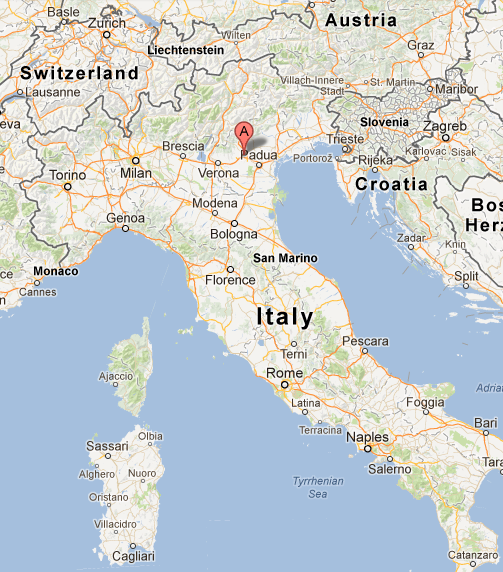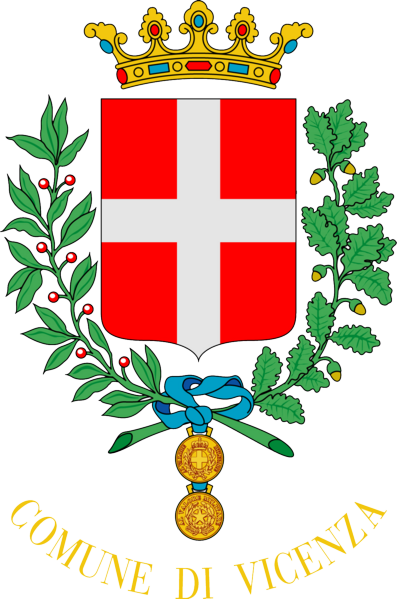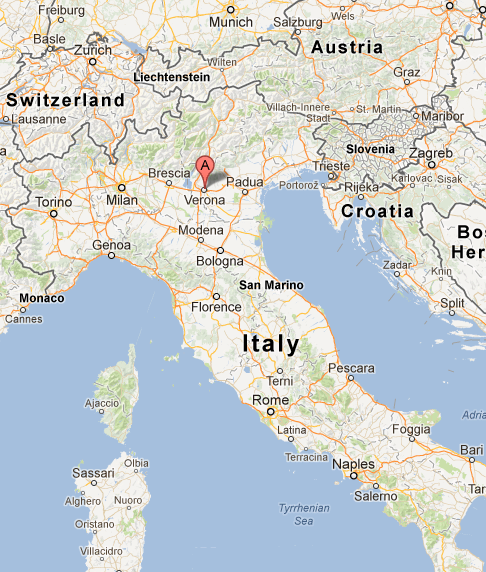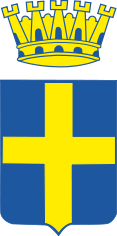<Back to Index>
This page is sponsored by:
PAGE SPONSOR


Vicenza, a city in north - eastern Italy, is the capital of the eponymous province in the Veneto region, at the northern base of the Monte Berico, straddling the Bacchiglione. Vicenza is approximately 60 km west of Venice and 200 km east of Milan.
Vicenza is a thriving and cosmopolitan city, with a rich history and culture, and many museums, art galleries, piazzas, villas, churches and elegant Renaissance palazzi. With the Palladian Villas of the Veneto in the surrounding area, and his renowned Teatro Olimpico (Olympic Theater), the "city of Palladio" has been enlisted as UNESCO World Heritage Site since 1994.
As of December 2008, Vicenza had an estimated population of c. 115,927, and a metropolitan area of 270 000. Vicenza is the third largest Italian industrial center as measured by the value of its exports, and is one of the country's wealthiest cities. Especially due to its textile and steel industries which employ tens of thousands and about one fifth of the country's gold and jewelry which is made in Vicenza, greatly contributing to the city's economy. Another important branch is the engineering / computer components industry (Federico Faggin, the microprocessor's co-inventor was born in Vicenza).
Vicentia was settled by the Italic Euganei tribe and then by the Paleo - Veneti tribe in the third and second centuries BC. The Romans allied themselves with the Paleo - Veneti in their fight against the Celtic tribes that populated north - western Italy. The Roman presence in the area grew exponentially over time and the Paleo - Veneti (whose culture mirrored Etruscan and Greek values more so than Celtic ones) were gradually assimilated. In 157 BC, the city was a de facto Roman center and was given the name of Vicetia or Vincentia, meaning "victorious".
The population of Vicentia received Roman citizenship in 49 BC. The city had some importance as a way station on the important road from Mediolanum (Milan) to Aquileia, near Tergeste (Trieste), but it was overshadowed by its neighbor Patavium (Padua). Little survives of the Roman city, but three of the bridges across the Bacchiglione and Retrone rivers are of Roman origin, and isolated arches of a Roman aqueduct exist outside the Porta Santa Croce.
During the decline of the Western Roman Empire, Heruls, Vandals, Alaric and his Visigoths, as well as the Huns laid waste to the area, but the city recovered after the Ostrogoth conquest in 489 AD, before passing to Byzantine rule soon after. It was also an important Lombard city and then a Frankish center. Numerous Benedictine monasteries were built in the Vicenza area, beginning in the sixth century.
In 899, Vicenza was destroyed by Magyar raiders.
In 1001, Otto III handed over the government of the city to the bishop, and its communal organization had an opportunity to develop, separating soon from the episcopal authority. It took an active part in the League with Verona and, most of all, in the Lombard League (1164 – 1167) against Emperor Frederick I Barbarossa compelling Padua and Treviso to join: its podestà, Ezzelino II il Balbo, was captain of the league. When peace was restored, however, the old rivalry with Padua, Bassano, and other cities was renewed, besides which there were the internal factions of the Vivaresi (Ghibellines) and the Maltraversi (Guelphs).
The tyrannical Ezzelino III from Bassano drove the Guelphs out of Vicenza, and caused his brother, Alberico, to be elected podestà (1230). The independent commune joined the Second Lombard League against Emperor Frederick II, and was sacked by that monarch (1237), after which it was annexed to Ezzelino's dominions. On his death the old oligarchic republic political structure was restored - a consiglio maggiore ("grand council") of four hundred members and a consiglio minore ("small council") of forty members - and it formed a league with Padua, Treviso and Verona. Three years later the Vicentines entrusted the protection of the city to Padua, so as to safeguard republican liberty; but this protectorate (custodia) quickly became dominion, and for that reason Vicenza in 1311 submitted to the Scaligeri lords of Verona, who fortified it against the Visconti of Milan.
Vicenza came under rule of Venice in 1404, and its subsequent history is that of Venice. It was besieged by the Emperor Sigismund, and Maximilian I held possession of it in 1509 and 1516.
Vicenza was a candidate to host the Council of Trent.
The 16th century was the time of Andrea Palladio, who left many outstanding examples of his art with palaces and villas in the city's territory, which before Palladio's passage, was arguably the most downtrodden and esthetically lacking of the Veneto.
After 1797, under Napoleonic rule, it was made a duché grand - fief (not a grand duchy, but a hereditary (extinguished in 1896), nominal duchy, a rare honor reserved for French officials) within Bonaparte's personal Kingdom of Italy for general Caulaincourt, also imperial Grand - Écuyer.
After 1814, Vicenza passed to the Austrian Empire. In 1848, however, the populace rose against Austria, more violently than in any other Italian center apart from Milan and Brescia (the city would receive the highest award for military valor for the courage displayed by revolutionaries in this period). As a part of the Kingdom of Lombardy - Venetia, it was annexed to Italy after the 3rd war of Italian independence.
Vicenza's area was a location of major combat in both World War I (on the Asiago plateau) and World War II (a focal center of the Italian resistance), and it was the most damaged city in Veneto by Allied bombings, including many of its monuments; the civil victims were over 2,000. After the end of the latter, what followed was a period of depression following the devastation caused by two world conflicts. In the 1960s the whole central part of Veneto, witnessed a strong economic development caused by the emergence of small and medium family businesses, ranging over a vast array of products (that often emerged illegally) that paved the way for what would be known as the "miracolo del Nordest". In the following years, the economic development grew rapidly. Huge industrial areas sprouted around the city, massive and disorganized urbanization and employment of foreign immigrants increased.
In 1994 UNESCO inscribed "Vicenza, City of Palladio" on its list of World Heritage Sites. In 1996 the site was expanded to include the Palladian villas outside the core area, and accordingly renamed "City of Palladio and the Palladian Villas of the Veneto".
Vicenza is home to twenty - three buildings designed by Palladio. The famous ones include:
- Villa Almerico Capra (also known as "La Rotonda"), located just outside the downtown area;
- Basilica Palladiana, centrally located in Vicenza's Piazza dei Signori, of which Palladio himself said that it might stand comparison with any similar work of antiquity;
- Teatro Olimpico, designed for the Accademia Olimpica and begun to be built in 1580, when Palladio died. The wooden scenes are by Vincenzo Scamozzi;
- Palazzo Chiericati, home of the Town pinacotheca;
- Palazzo Barbaran da Porto, home of the Museo Palladio;
- Palazzo del Capitaniato, home of the Town council;
- Palazzo Porto;
- Palazzo Porto in Piazza Castello (unfinished);
- Palazzo Thiene Bonin Longare (built by Vincenzo Scamozzi);
- Palazzo Thiene;
- Villa Gazzotti Grimani, in the frazione Bertesina.
Some of the main historical churches:
- The Cathedral of Vicenza (church of Santa Maria Annunciata), dating from early in the 11th century, and restored in the 13th, 16th, 19th and after the ruinous destruction of World War II, possesses numerous pictures and sculptures, nearly all of them by Vicentine artists (Cittadello, Celestia, Liberi, Ruschi);
- The Church of Araceli (1244), by Guarino Guarini, formerly belonged to the Clarisses, contains statues by Orazio Marinali and Cassetti, and paintings by Tiepolo;
- The Churches of the Carmini (1372) and St. Catherine (1292), formerly belonging to the Humiliati, possess notable pictures;
- Santa Corona (1260) was built by the Dominicans after the death of Ezzelino, and is pictured by Montagna (The Magdelene) and Bellini (Baptism of Christ); it also hosts the Valmarana chapel by Palladio;
- Santa Croce (1179);
- Santi Felice and Fortunato (8th century);
- Santi Filippo and Giacomo (12th century);
- San Lorenzo of the Friars Minor (1280), in the Gothic style, contains the tombs of many illustrious Vicentines;
- San Marco in San Girolamo (18th century), baroque church built by the Discalced Carmelites;
- In the cloister of S. Maria of the Servites (1319) took place the miracles of St. Philip Benizi de Damiani.
- The Torre Bissara (clock tower) (1224 – 1446), 82m, is one of the tallest buildings;
- The Biblioteca Civica Bertoliana, public library founded by Count Giovanni M. Bertolo, opened 1708;
- Casa Pigafetta (1440), house of Antonio Pigafetta;
- The Pinacotheca Civica houses mainly Vicentine paintings in the Palladian Palazzo Chiericati.


Verona (Venetian Verona, pron. Veròna) is a city in the Veneto, northern Italy, with approx. 265,000 inhabitants and one of the seven chef-lieus of the region. It is the second largest city municipality in the region and the third of northeast Italy. The metropolitan area of Verona covers an area of 1,426 km2 (550.58 sq mi) and has a population of 714,274 inhabitants. It is one of the main tourist destinations in northern Italy, owing to its artistic heritage, several annual fairs, shows and operas, such as the lyrical season in the Arena, the ancient amphitheater built by the Romans.
The city has been awarded World Heritage Site status by UNESCO because of its urban structure and architecture.
The precise details of Verona's early history remain a mystery. The origin of the name Verona is also unknown. One theory assumes it was a city of the Euganei, who were obliged to give it up to the Cenomani (550 BC). With the conquest of the Vaecame Roman (about 300 BC) Verona became a Roman colonia in 89 BC, and then a municipium in 49 BC; Verona had the franchise in 59.
The city became important because it was at the intersection of several roads. Stilicho defeated Alaric and his Visigoths here in 403. But, after Verona was conquered in (489 AD) the Gothic domination of Italy began; Theodoric built his palace there, and according to Irish legends that is what Verona was named after. It remained under the power of the Goths throughout the Gothic War (535 – 552), except for a single day in 541, when the Armenian officer Artabazes made an entrance. The defections that took place among the Byzantine generals with regard to the booty made it possible for the Goths to regain possession of the city. In 552 Valerian vainly endeavored to enter it, but only when they were fully overthrown, the Goths surrendered it.
In 569, it was taken by Alboin, King of the Lombards, in whose kingdom it was, in a sense, the second most important city. There, Alboin himself was killed by his own wife in 572. The dukes of Treviso often resided there. At Verona Adalgisus, son of Desiderius, in 774 made his last desperate resistance to Charlemagne, who had destroyed the Lombard kingdom. Verona was then the ordinary residence of the kings of Italy, the government of the city becoming hereditary in the family of Count Milo, progenitor of the counts of San Bonifacio. From 880 to 951 the two Berengarii resided there. Otto I ceded to Verona the marquisate dependent on the Duchy of Bavaria.
The reign of his son Alberto as capitano (1277 – 1302) was one incessant war against the counts of San Bonifacio, who were aided by the House of Este. Of his sons, Bartolomeo, Alboino and Cangrande I, only the last shared the government (1308); he was great as warrior, prince and patron of the arts; he protected Dante, Petrarch and Giotto. By war or treaty, he brought under his control the cities of Padua (1328), Treviso (1308) and Vicenza.
Alberto was succeeded by Mastino II (1329 – 1351) and Alberto, sons of Alboino. Mastino continued his uncle's policy, conquering Brescia in 1332 and carrying his power beyond the Po. He purchased Parma (1335) and Lucca (1339). After the King of France, he was the richest prince of his time. But a powerful league was formed against him in 1337 – Florence, Venice, the Visconti, the Este, and the Gonzaga. After a three years war, the Scaliger dominions were reduced to Verona and Vicenza (Mastino's daughter Regina - Beatrice della Scala married to Barnabò Visconti). Mastino's son Cangrande II (1351 – 1359) was a cruel, dissolute, and suspicious tyrant; not trusting his own subjects, he surrounded himself with Brandenburg mercenaries. He was killed by his brother Cansignorio (1359 – 1375), who beautified the city with palaces, provided it with aqueducts and bridges, and founded the state treasury. He also killed his other brother, Paolo Alboino. Fratricide seems to have become a family custom, for Antonio (1375 – 87), Cansignorio's natural brother, slew his brother Bartolomeo, thereby arousing the indignation of the people, who deserted him when Gian Galeazzo Visconti of Milan made war on him. Having exhausted all his resources, he fled from Verona at midnight (19 October 1387), thus putting an end to the Scaliger domination, which, however, survived in its monuments.
The year 1387 is also the year of the famous Battle of Castagnaro, between Giovanni Ordelaffi, for Verona, and John Hawkwood, for Padua, who was the winner.
Antonio's son Canfrancesco in vain attempted to recover Verona (1390).
Guglielmo (1404), natural son of Cangrande II, was more fortunate; with the support of the people, he drove out the Milanese, but he died ten days after, and Verona then submitted to Venice (1405). The last representatives of the Scaligeri lived at the imperial court and repeatedly attempted to recover Verona by the aid of popular risings.
From 1508 to 1517, the city was in the power of the Emperor Maximilian I. There were numerous outbreaks of the plague, and in 1629 – 33 Italy was struck by its worst outbreak in modern times. In Verona an estimated 33,000 people (of a total of 54,000) died in 1630 – 1631.
In 1776 was developed a method of bellringing called Veronese bellringing art. Verona was occupied by Napoleon in 1797, but on Easter Monday the populace rose and drove out the French. It was then that Napoleon made an end of the Venetian Republic. Verona became Austrian territory when Napoleon signed the Treaty of Campo Formio in October, 1797. The Austrians took control of the city on January 18, 1798. It was taken from Austria by the Treaty of Pressburg in 1805 and became part of Napoleon's Kingdom of Italy, but was returned to Austria following Napoleon's defeat in 1814, when it became part of the Austrian held Kingdom of Lombardy - Venetia. In 1866, following the Six Weeks War, Verona, along with the rest of Venetia, became part of Italy.
In 1866, on the anniversary of the defeat of Königrätz, the Austrians evacuated Verona, their strongest fortress in Venetia, which thus became Italian.
The advent of fascism added another dark chapter to the annals of Verona. As throughout Italy, the Jewish population was hit by the anti - Semitic laws (1938), and after the invasion by Nazi Germany in 1943, deportations to Nazi concentration camps. An Austrian Fort (now a church, the Santuario della Madonna di Lourdes), was used to incarcerate and torture allied troops, Jews and anti - fascist suspects especially after 1943, when Verona became part of the Repubblica di Salò or "Social Republic".
As in Austrian times, Verona became of great strategic importance to the regime. Galeazzo Ciano, Benito Mussolini's son in law was accused of plotting against the republic during a mock trial staged by the Nazi and fascist hierarchy in Castelvecchio. Ciano was executed on the banks of the Adige with many other officers on what is today Via Colombo. This marked another turning point in the escalation of violence that would only end with the final liberation by allied troops and partisans in 1945.
Because of the value and importance of its many historical buildings, Verona has been named a UNESCO World Heritage Site. Verona preserved many ancient Roman monuments, no longer in use, in the early Middle Ages, but much of this and much of its early medieval edifices were destroyed or heavily damaged by the earthquake of 3 January 1117, which led to a massive Romanesque rebuilding. The Carolingian period Versus de Verona contains an important description of Verona in the early medieval era.
The Roman military settlement in what is now the center of the city was to expand through the cardi and decumani that intersect at right angles. This structure has been kept to the present day and is clearly visible from the air. Further development has not reshaped the original map. Though the Roman city with its basalt paved roads is mostly hidden from view it stands virtually intact about 6 m below the surface. Most palazzi and houses have cellars built on Roman artifacts that are rarely accessible to visitors. Piazza delle Erbe, near the Roman forum was rebuilt by Cangrande I and Cansignorio della Scala I, lords of Verona, using material (such as marble blocks and statues) from Roman spas and villas.
Verona is famous for its Roman amphitheater, the Arena found in the city's largest piazza, the Piazza Bra. Completed around 30 AD, it is the third largest in Italy after Rome's Colosseum and the arena at Capua. It measures 139 metres long and 110 metres wide, and could seat some 25,000 spectators in its 44 tiers of marble seats. The ludi (shows and gladiator games) performed within its walls were so famous that they attracted spectators from far beyond the city. The current two - story façade is actually the internal support for the tiers; only a fragment of the original outer perimeter wall in white and pink limestone from Valpolicella, with three stories remains.The interior is very impressive and is virtually intact, and has remained in use even today for public events, fairs, theater and open - air opera during warm summer nights.
There is also a variety of other Roman monuments to be found in the town, such as the Roman theater of Verona. This theater was built in the 1st century BC, but through the ages had fallen in disuse and had been built upon to provide housing. In the 18th century Andrea Monga, a wealthy Veronese, bought all the houses that in time had been built over the theater, demolished them, and saved the monument. Not far from it is the Ponte di Pietra ("Stone Wall Bridge"), another Roman landmark that has survived to this day.
The Arco dei Gavi (Gavi Arch) was built in the 1st century AD, and is famous for having the name of the builder (architect Lucius Vitruvius Cordone) engraved on it, a really rare case in the architecture of the era. It originally straddled the main Roman road into the city, now the Corso Cavour. It had been demolished by the French troops in 1805 and was rebuilt in 1932.
Nearby is the Porta Borsari, an archway at the end of Corso Porta Borsari. This is the façade of a 3rd century gate in the original Roman city walls. The inscription is dated 245 AD and gives the city name as Colonia Verona Augusta. Corso Porta Borsari, the road passing through the gate is the original Via Sacra of the Roman city. Today, it is lined with several Renaissance palazzi and the ancient Church of SS. Apostoli, a few meters from Piazza delle Erbe.
Porta Leoni is the 1st century BC ruin of what was once part of the Roman city gate. A substantial portion is still standing as part of the wall of a medieval building. The street itself is an open archaeological site, and the remains of the original Roman street and gateway foundations can be seen a few feet below the present street level. As can be seen from there, the gate contains a small court guarded by towers. Here, carriages and travelers were inspected before entering or leaving the city.
The Basilica of San Zeno Maggiore is considered one of the great achievements of Romanesque architecture. The present structure is the 3rd on this site, built from 1123 – 1135, over the 4th century shrine to Verona's patron saint, St. Zeno (died 380). The façade dominates the large square, and is flanked with a beautiful 72 meter tall bell tower, which is mentioned by Dante in Canto 18 of Purgatory in the Divine Comedy. The weathered Veronese stone gives a warm golden glow and the restrained lines of the pillars, columns, cornices and the gallery with its double windows give the façade an air of harmonious elegance. The huge rose window is decorated as a Wheel of Fortune. The lintels above the portal have carvings of the months of the year. Each side of the doorway is embellished with 18 bas - relief panels of biblical scenes, and the inner bronze door has panels have 48 primitive but forceful Biblical scenes and depictions from the life of St Zeno. The meaning of some of the scenes is now unknown, but the extraordinarily vivid, barbaric energy of the figures is a superb blend of traditional and Ottonian influences. The interior of the church is divided into a Lower Church, occupying about 2/3 of the structure, and the Upper Church, occupying the remainder. The walls are covered with 12th and 14th century frescoes and the ceiling of the nave is a magnificent example of a ship's keel ceiling. The vaulted crypt contains the tomb of St. Zeno, the first Bishop of Verona, as well as the tombs of several other saints. North of the church is a pleasant cloister. The church also houses the tomb of King Pippin of Italy (777 – 810).
The small Romanesque Basilica of San Lorenzo is one of the finest and most important in the city. Its dates from around 1177, but is built on the site of a Paleochristian church, some fragments of which remain. The church is built of alternating tracks of brick and stone, and has two cylindrical towers, housing spiral staircases to the women's galleries. Inside, the atmosphere is rather severe, but is still quiet and peaceful. The striped bands of stone and brick and the graceful arches complement the setting.
With a span length of 48.70 m (159.78 ft), the 1356 completed segmental arch bridge Ponte Scaligero featured at the time the world's largest bridge arch.
Santa Maria Antica is a huge Romanesque church was the parish church of the Scaligeri clan, and is famous for the Gothic Scaliger Tombs. The Duomo is also a notable Romanesque church.
Sant' Anastasia is a huge and lofty church built from 1290 – 1481 by the Dominicans to hold the massive congregations attracted by their rousing fundamentalist sermons. The Pellegrini chapel houses the famous fresco St. George and the Princess of Trebizond by Pisanello as well as the grave of Wilhelm von Bibra. The famous square also holds its art festival in May.